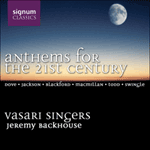Bless the Lord, O my soul, a setting of Psalm 104, was commissioned by the Eton Old Choristers’ Association to celebrate the choristers’ part in the school’s life from its foundation by Henry VI in 1440 until the choir school’s closure in 1968. This piece is a paean of praise which is characterized by the opening flourishes on the organ and the outburst of joyful, canonic, wordless singing (to ‘Ah’) which forms the choir’s first entry. The music then moves backwards and forwards between the piano staccato chords which accompany the choir’s first line of text, more organ filigree work from the opening, and big forte chords with the choir’s wordless canon. The second section (‘who coverest thyself with light’) has the choir imitating the trebles’ first phrase in another extended canonic progression under which the organ develops the filigree figure from the start into a moto perpetuo. The opening returns with what Dove has almost now made into a mantra of the first words ‘Bless the Lord, O my soul’. The final section increases in volume, intensity and excitement to bring the anthem to a dazzling conclusion.
from notes by Paul Spicer © 2010
Bless the Lord, O my soul, une mise en musique du psaume 104 fut commandée par l’Eton Old Choristers’ Association pour célébrer le rôle des choristes dans la vie de l’école, depuis sa fondation par Henri VI en 1440. Il s’agit d’un dithyrambe caractérisé par des fioritures initiales à l’orgue et par une explosion de chant sans paroles (sur «Ah»), joyeux et canonique, qui forme la première entrée chorale. Puis la musique oscille entre les accords staccato piano accompagnant le premier verset choral, un travail organistique filigrané de l’ouverture et de gros accords forte avec le canon sans texte du chœur. La deuxième section («who coverest thyself with light») voit le chœur imiter la première phrase des trebles dans une autre progression canonique étoffée, par-dessous laquelle l’orgue développe la figure filigranée du début en un moto perpetuo. L’ouverture revient avec les premiers mots «Bless the Lord, O my soul», dont Dove a désormais presque fait un mantra. La dernière section gagne en volume, en intensité et en ferveur pour offrir à l’anthem une conclusion éblouissante.
extrait des notes rédigées par Paul Spicer © 2010
Français: Hypérion
Bless the Lord, O my soul ist ein Vertonung des 104. Psalms, die von der Eton Old Choristers’ Association in Auftrag gegeben wurde, um den Beitrag des Schulchors zur Geschichte der 1440 von Heinrich VI. gegründeten Chorschule bis zu ihrer Auflösung im Jahr 1968 zu feiern. Dieser Lobgesang wird bestimmt von den einleitenden Orgelverzierungen und dem freudvoll ausbrechenden kanonischen ersten Einsatz des Chors ohne Worte auf der Silbe „Ah“. Anschließend wendet die Musik sich rück- und vorwärts zwischen piano gespielten Stakkatoakkorden zur Begleitung der ersten Textzeile des Chors, weiterem Filigranwerk aus der Einleitung auf der Orgel und großen, forte gespielten Akkorden zum wortlosen Kanon des Chors. Im zweiten Abschnitt („who coverest thyself with light“ / Licht ist dein Kleid) imitiert der Chor die erste Phrasierung des Soprans mit einer weiteren kanonischen Progression, unter der die Orgel die Filigranfigur der Einleitung zu einem moto perpetuo entwickelt. Die Einleitung kehrt mit der ersten Textzeile „Bless the Lord, O my soul“ gleichsam in Gestalt einer Gebetsformel zurück. Der letzte Abschnitt bringt die Hymne mit gesteigerter Lautstärke, Intensität und Erregung zu einem überwältigenden Abschluss.
aus dem Begleittext von Paul Spicer © 2010
Deutsch: Henning Weber


 Anthems for the 21st century
Anthems for the 21st century
